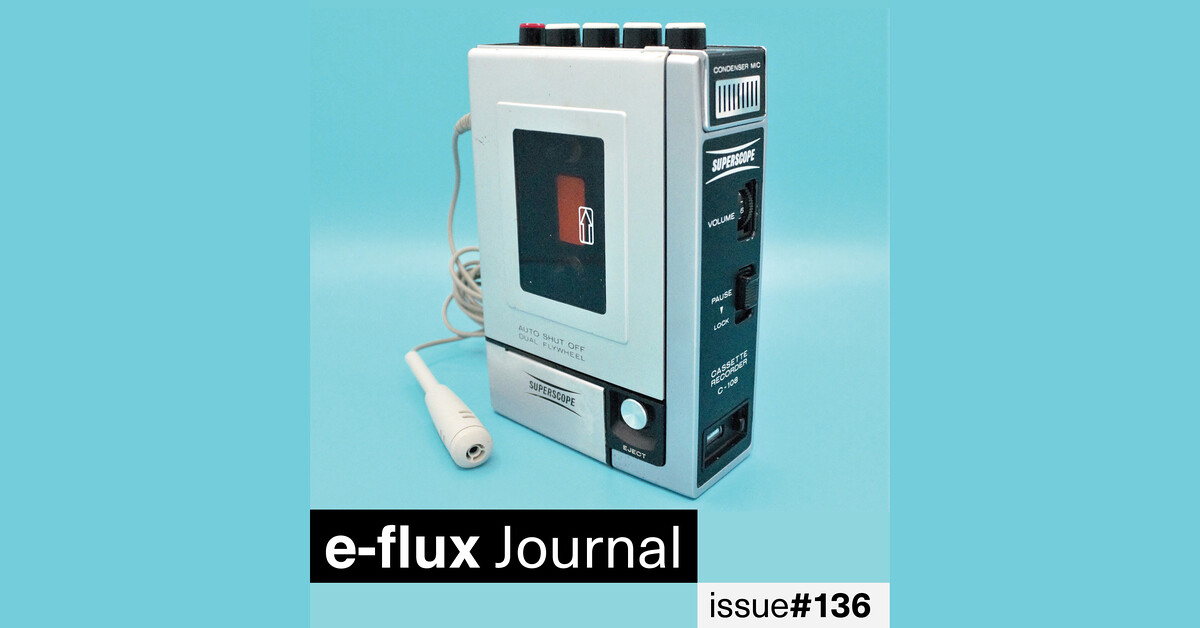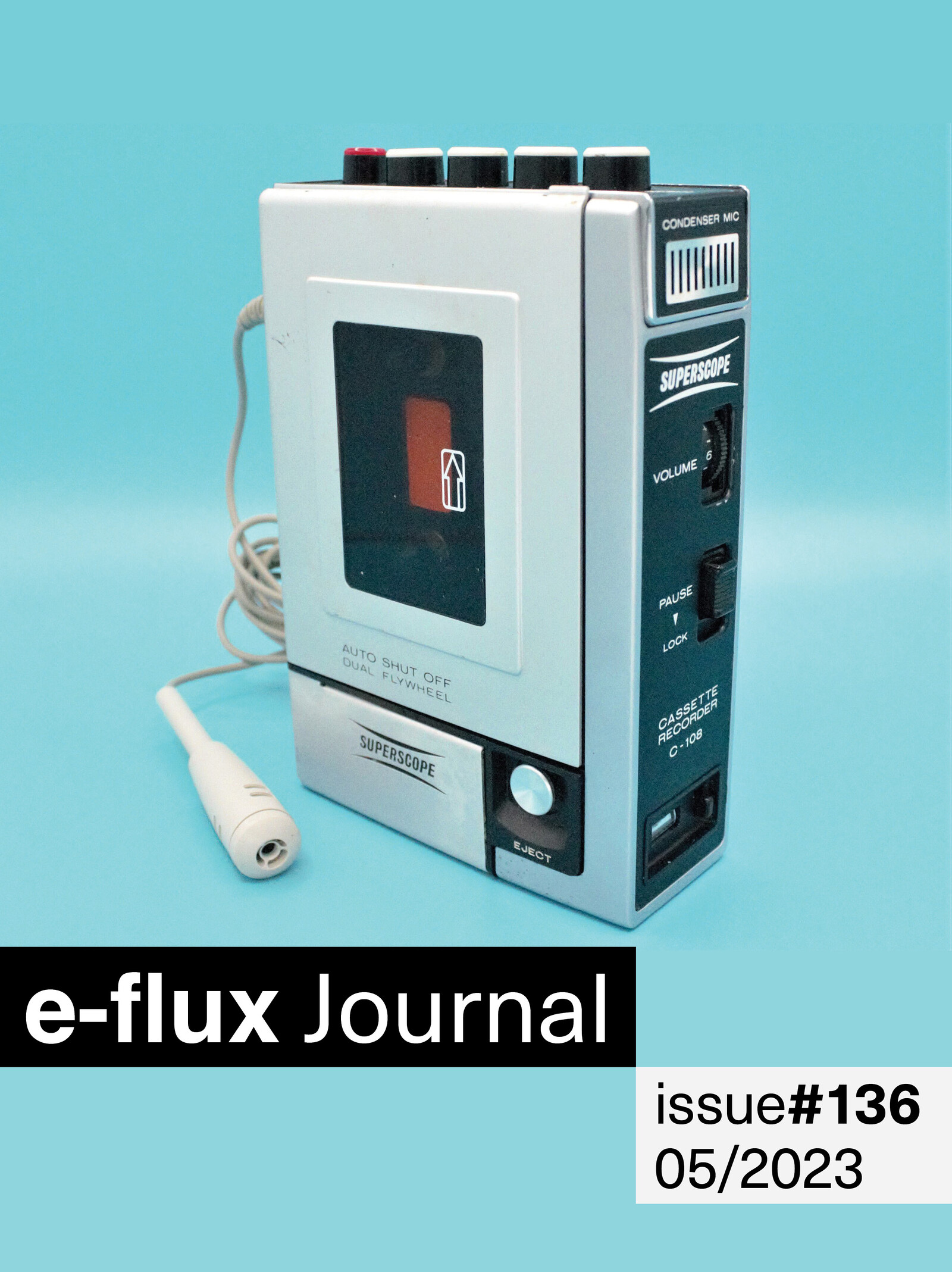with a cat, Marcel Broodthaers, Yuk Hui, Barry Schwabsky, Renee Gladman, Boris Groys, Alice Wang, Elizabeth Willis, Steve McQueen, Doreen Mende, Mary N. Taylor, Janet Sarbanes, Hugo García Manríquez, Liam Gillick, Jörg Heiser, Tina M. Campt, and Jace Clayton
Part of what makes interviews so engaging to read is that they presume to share ideas on the fly, in a social setting and in the world. In comparison, written essays feel like constructed machines, lean and airtight with beginnings, middles, and ends. No wonder interviews, as a whole, seem a bit decadent in their procrastinatory pleasure. It’s like they catch interlocutors off guard when they should be doing something more serious. Interestingly though, the informality of speech is also a ruse, and a formal challenge for those who prefer to construct words and ideas methodically, because things sometimes spill out that wouldn’t be disciplined into more structured writing and thinking.
This is where interviews also dance around the edges of how ideas are structured and delivered. Placed in a social setting, thinking becomes inseparable from the person doing the thinking. How do they speak as regular people? How do they move from one idea to the next, reach out to get the vibe of the other person, or employ indulgent asides, personal rapport, and charm, all just to get a feeling of the point across? You might catch someone betraying themselves, or on the other hand, exposing how their vulnerabilities and their ideas are in fact terrifyingly integrated. You may find their intuitions more relevant than the work they’re known for. In some cases, the simple act of talking to another person might actually be more rigorous, and in other cases not.
Such a concern with the personality piloting the machine was surely something Andy Warhol understood when he and others started inter/VIEW in the late 1960s. No wonder the magazine was informally called the “crystal ball of pop,” since assembling details gathered from many key media personalities caught off guard could certainly constitute a prophetic power within society. Today we might dismiss Warhol’s playful pandering to attention and acclaim, especially because the publishing industry was much more centralized at the time. But we can’t deny the mesmeric and contradictory appeal of public figures expressing intimate thoughts.
We might linger for a moment on the conjunction of prophecy and intimacy, since the interview format is also the medium of oral history accounts, of stories that are recorded insofar as they are told and positional and subjective accounts of events that may or may not gel with the overarching synthesis of grand narratives. With oral history, the interview or conversational exchange is not the casual version of something else, but the absolute vehicle of transmission. Some might suppose oral history to be a last resort, whether due to a lack of literacy or modern institutions, or to possible trauma experienced by the teller. And yet, our own peculiar attraction to the humble exchange of stories and ideas between two people suggests that there is a more complex pact between two people that makes the format a highly privileged one.
Whether an interview is on or off the record, sometimes that pact is made between interlocutors who are accustomed, like many artists, to communicating ideas, movement, and images beyond words. Other times the pact is made between beings speaking very different languages. In 1970, Belgian poet-turned-artist Marcel Broodthaers recorded an interview with a cat about painting, the move from conceptual art to figuration, market value, and closing down museums. Their dialogue opens this special issue of e-flux journal composed solely of conversation, poetry, and prose by poets.
Also in this issue, Yuk Hui speaks to Barry Schwabsky on the necessity of identifying differences and formalizing incompatibilities. In a sweeping exchange that traverses artworks, cultural cosmologies, and technical systems, irreconcilable oppositions and dialectical circuits animate images just as they determine the possibility for diversity.
Renee Gladman describes a stillness permeating a world that values constant movement. Over the light and shadow of a day, a writer sits among ancient objects waiting for something hot. As the objects—ceramic, wood, ivory, iron—reveal and suppress their care and use, they teem with a darkness from inside. As everything goes quiet, a choreography emerges; pressure builds for action.
In conversation with Alice Wang, Boris Groys charts Russian cosmists’ criticism of the classical Marxist insistence that the end of history will satisfy “normal” human needs. Instead, the Immortal Biocosmists in particular believed that people desire things that can only be provided by a communist system promising immortality. In the present, Wang and Groys urge public discourse on interplanetary governance, human colonization of space, and other ethical problems that must be negotiated before our departure.
Through a poem named for the future imperfect tense, Elizabeth Willis shapes a connection between the physical and metaphysical worlds. Delving into the troubled history of the human condition, Wills draws from Octavia Butler’s quantum thought, extractive forces like the pearl button industry, W.E.B. Du Bois’s data portraits, and Paul Robeson’s activism with miners. History becomes an ongoing, speculative process.
Steve McQueen speaks with Doreen Mende on the erasures and silences within Eslanda and Paul Robeson’s unclassified FBI files. McQueen calls the redacted portions black holes, and observes that the files reveal as much about the failures of state surveillance as about the Robesons themselves. McQueen’s installation End Credits also celebrates the Robesons’ lasting triumphs and the strength of their vulnerabilities. Broad implications of memory politics and intersectional solidarity reverberate.
Mary N. Taylor and Janet Sarbanes explore the role of art within a concept of autonomy where the relationship between the individual and collective is mutually constitutive. The limitations of the modernist notion of separate spheres for art and politics give way to the potential for a new understanding of autonomy to emerge.
Poet Hugo García Manríquez plumbs and indexes the contents of armories and palacios de bellas artes, all full of precise prices for what the Mexican government spends on weapons. Such places are histories ripe for a writer’s confrontation: Protect the libraries from the masses or side with forms of language that emerge from riot?
Liam Gillick shows Jörg Heiser his cinematic approach to an intervention in the Ancient Near East collection of the Pergamon Museum. The project, Filtered Time, was realized amidst debates over closing and remodeling the buildings and the fraught colonial histories they house. With equal parts layered historical research, punk-informed questions, and an unhelpful sense of destruction, Gillick eyes the false cultural oppositions that served British and German identity-building in a time where that’s all happening again.
Tina M. Campt, in talking with Jace Clayton, is clear that synesthesia is not a metaphor. Rather, we can listen to images, to think the sonic and the visual in chorus. Campt and Clayton discuss collaboration in fields populated by artists and thinkers too often rendered as solitary voices. And after recent years marked by profound isolation, Campt emphasizes the absolute need for and magic of the multisense reverberations between audiences, speakers, artists, and thinkers in conversation.
—Editors


